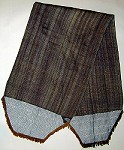 |
|
| Home |
|

Mexican Rebozo ca. 1891 Mexico Catalog Information |
 |
Design |
|
The delicate stripes in this rebozo were created through a complicated method of dyeing called ikat. The striped design of the main body of the piece is complemented by a net-like section and fringe on either end. All rebozos are decorated with some sort of fringe, which ranges from simple to ornate. Ignatius Pfefferkorn, a Jesuit missionary in northern Mexico during the mid-18th century,
noted the wide range in rebozo designs and how design differences
reflected social status: |

|
Gallery | Map | Timeline | Glossary | Catalog | About | Home |